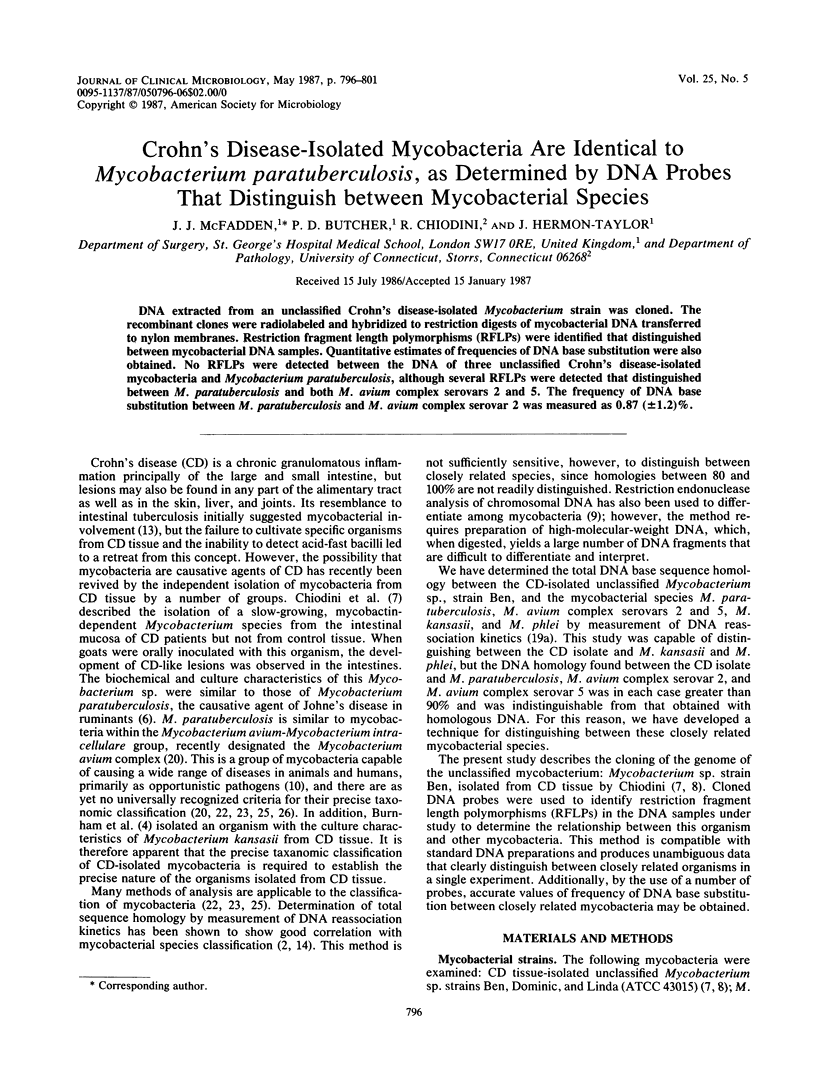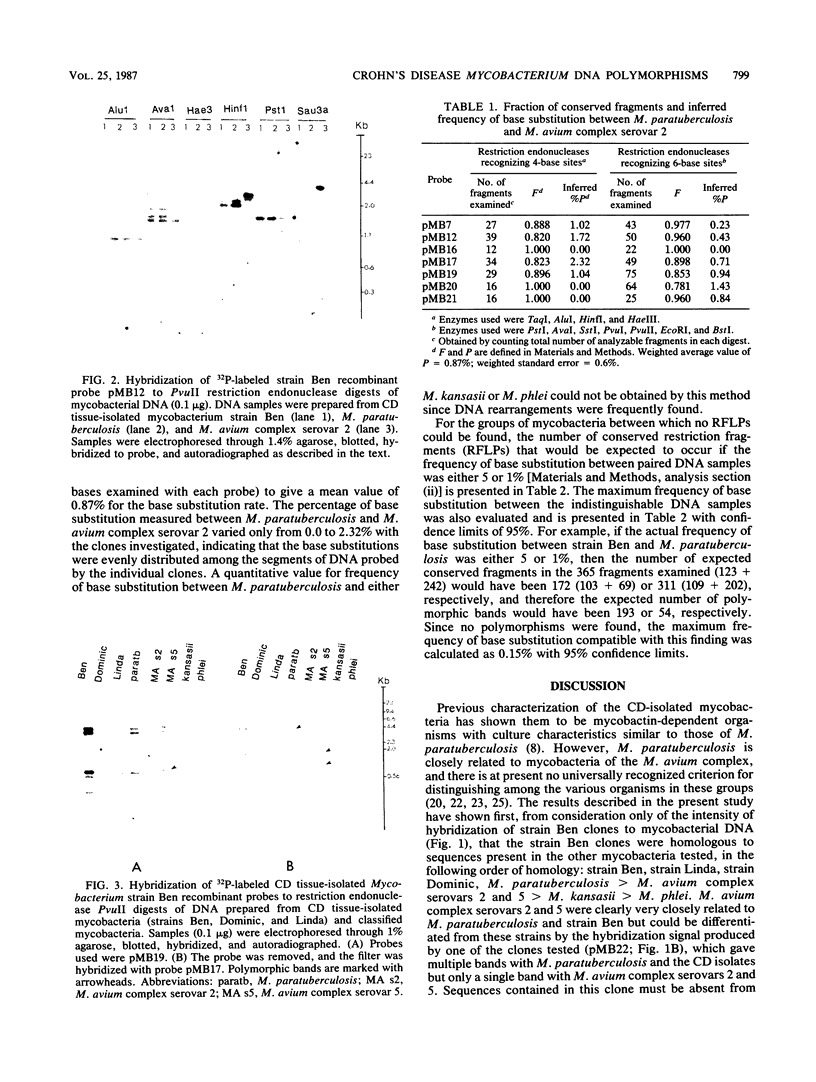Abstract
DNA extracted from an unclassified Crohn's disease-isolated Mycobacterium strain was cloned. The recombinant clones were radiolabeled and hybridized to restriction digests of mycobacterial DNA transferred to nylon membranes. Restriction fragment length polymorphisms (RFLPs) were identified that distinguished between mycobacterial DNA samples. Quantitative estimates of frequencies of DNA base substitution were also obtained. No RFLPs were detected between the DNA of three unclassified Crohn's disease-isolated mycobacteria and Mycobacterium paratuberculosis, although several RFLPs were detected that distinguished between M. paratuberculosis and both M. avium complex serovars 2 and 5. The frequency of DNA base substitution between M. paratuberculosis and M. avium complex serovar 2 was measured as 0.87 (+/- 1.2)%.
Full text
PDF





Images in this article
Selected References
These references are in PubMed. This may not be the complete list of references from this article.
- Anilionis A., Riley M. Conservation and variation of nucleotide sequences within related bacterial genomes: Escherichia coli strains. J Bacteriol. 1980 Jul;143(1):355–365. doi: 10.1128/jb.143.1.355-365.1980. [DOI] [PMC free article] [PubMed] [Google Scholar]
- Baess I. Deoxyribonucleic acid relatedness among species of slowly-growing mycobacteria. Acta Pathol Microbiol Scand B. 1979 Aug;87(4):221–226. doi: 10.1111/j.1699-0463.1979.tb02430.x. [DOI] [PubMed] [Google Scholar]
- Burnham W. R., Lennard-Jones J. E., Stanford J. L., Bird R. G. Mycobacteria as a possible cause of inflammatory bowel disease. Lancet. 1978 Sep 30;2(8092 Pt 1):693–696. doi: 10.1016/s0140-6736(78)92699-5. [DOI] [PubMed] [Google Scholar]
- Chiodini R. J. Biochemical characteristics of various strains of Mycobacterium paratuberculosis. Am J Vet Res. 1986 Jul;47(7):1442–1445. [PubMed] [Google Scholar]
- Chiodini R. J., Van Kruiningen H. J., Merkal R. S. Ruminant paratuberculosis (Johne's disease): the current status and future prospects. Cornell Vet. 1984 Jul;74(3):218–262. [PubMed] [Google Scholar]
- Chiodini R. J., Van Kruiningen H. J., Merkal R. S., Thayer W. R., Jr, Coutu J. A. Characteristics of an unclassified Mycobacterium species isolated from patients with Crohn's disease. J Clin Microbiol. 1984 Nov;20(5):966–971. doi: 10.1128/jcm.20.5.966-971.1984. [DOI] [PMC free article] [PubMed] [Google Scholar]
- Chiodini R. J., Van Kruiningen H. J., Thayer W. R., Merkal R. S., Coutu J. A. Possible role of mycobacteria in inflammatory bowel disease. I. An unclassified Mycobacterium species isolated from patients with Crohn's disease. Dig Dis Sci. 1984 Dec;29(12):1073–1079. doi: 10.1007/BF01317078. [DOI] [PubMed] [Google Scholar]
- Collins D. M., De Lisle G. W. DNA restriction endonuclease analysis of Mycobacterium bovis and other members of the tuberculosis complex. J Clin Microbiol. 1985 Apr;21(4):562–564. doi: 10.1128/jcm.21.4.562-564.1985. [DOI] [PMC free article] [PubMed] [Google Scholar]
- Collins P., Matthews P. R., McDiarmid A., Brown A. The pathogenicity of Mycobacterium avium and related mycobacteria for experimental animals. J Med Microbiol. 1983 Feb;16(1):27–35. doi: 10.1099/00222615-16-1-27. [DOI] [PubMed] [Google Scholar]
- Golde D. W. Aetiology of regional enteritis. Lancet. 1968 May 25;1(7552):1144–1145. doi: 10.1016/s0140-6736(68)90202-x. [DOI] [PubMed] [Google Scholar]
- Gross W. M., Wayne L. G. Nucleic acid homology in the genus Mycobacterium. J Bacteriol. 1970 Nov;104(2):630–634. doi: 10.1128/jb.104.2.630-634.1970. [DOI] [PMC free article] [PubMed] [Google Scholar]
- Grunstein M., Hogness D. S. Colony hybridization: a method for the isolation of cloned DNAs that contain a specific gene. Proc Natl Acad Sci U S A. 1975 Oct;72(10):3961–3965. doi: 10.1073/pnas.72.10.3961. [DOI] [PMC free article] [PubMed] [Google Scholar]
- HUGHES D. E. A press for disrupting bacteria and other micro-organisms. Br J Exp Pathol. 1951 Apr;32(2):97–109. [PMC free article] [PubMed] [Google Scholar]
- Harshman L., Riley M. Conservation and variation of nucleotide sequences in Escherichia coli strains isolated from nature. J Bacteriol. 1980 Nov;144(2):560–568. doi: 10.1128/jb.144.2.560-568.1980. [DOI] [PMC free article] [PubMed] [Google Scholar]
- McFadden J. J., Butcher P. D., Chiodini R. J., Hermon-Taylor J. Determination of genome size and DNA homology between an unclassified Mycobacterium species isolated from patients with Crohn's disease and other mycobacteria. J Gen Microbiol. 1987 Jan;133(1):211–214. doi: 10.1099/00221287-133-1-211. [DOI] [PubMed] [Google Scholar]
- Meissner G., Schröder K. H., Amadio G. E., Anz W., Chaparas S., Engel H. W., Jenkins P. A., Käppler W., Kleeberg H. H., Kubala E. A co-operative numerical analysis of nonscoto- and nonphotochromogenic slowly growing mycobacteria. J Gen Microbiol. 1974 Aug;83(2):207–235. doi: 10.1099/00221287-83-2-207. [DOI] [PubMed] [Google Scholar]
- Rigby P. W., Dieckmann M., Rhodes C., Berg P. Labeling deoxyribonucleic acid to high specific activity in vitro by nick translation with DNA polymerase I. J Mol Biol. 1977 Jun 15;113(1):237–251. doi: 10.1016/0022-2836(77)90052-3. [DOI] [PubMed] [Google Scholar]
- Stanford J. L., Grange J. M. The meaning and structure of species as applied to mycobacteria. Tubercle. 1974 Jun;55(2):143–152. doi: 10.1016/0041-3879(74)90008-7. [DOI] [PubMed] [Google Scholar]
- Upholt W. B. Estimation of DNA sequence divergence from comparison of restriction endonuclease digests. Nucleic Acids Res. 1977;4(5):1257–1265. doi: 10.1093/nar/4.5.1257. [DOI] [PMC free article] [PubMed] [Google Scholar]





